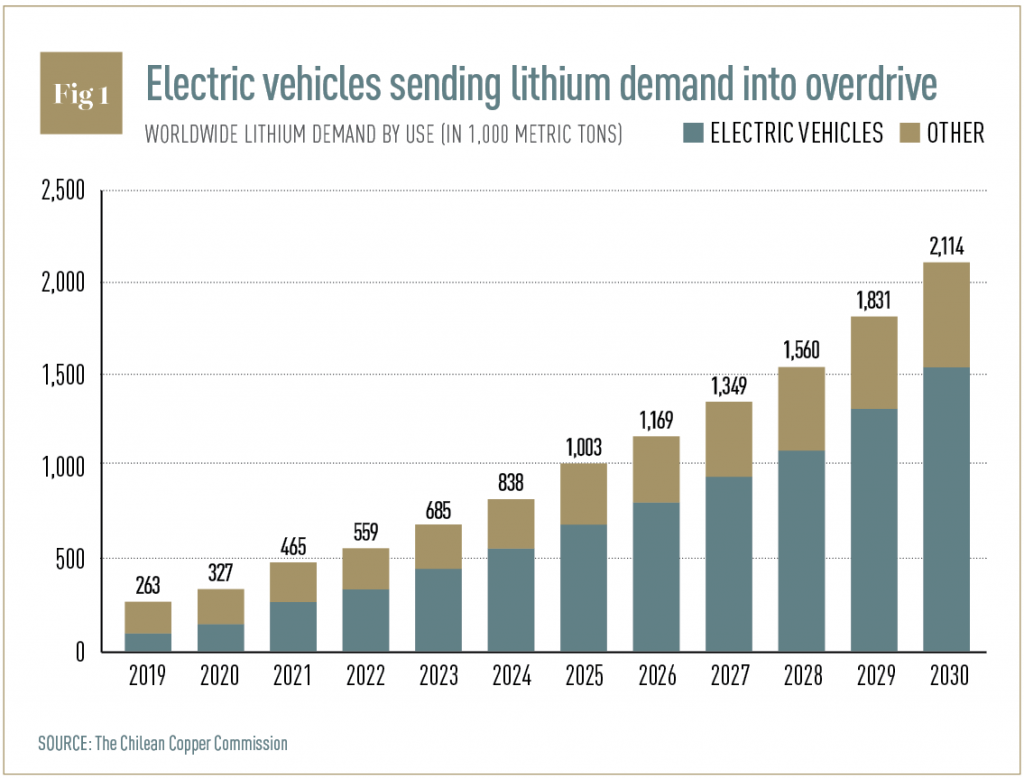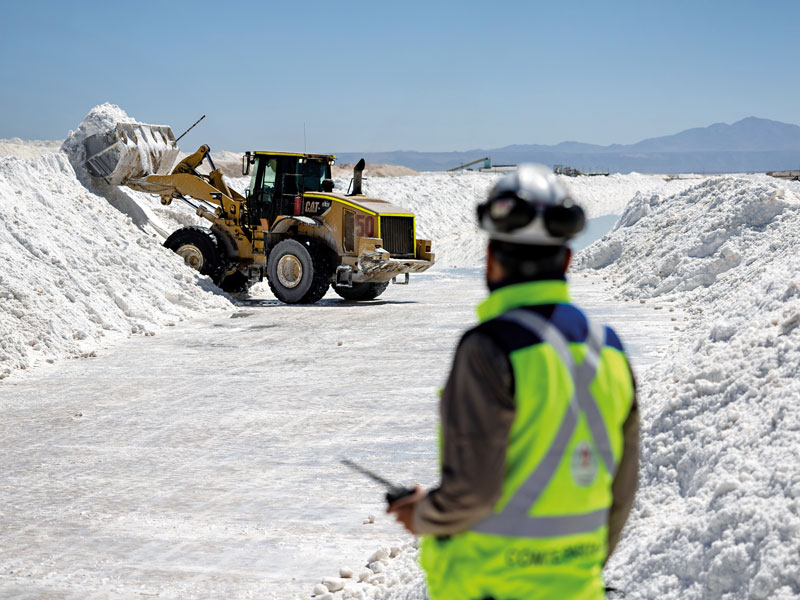‘White gold’ could remake the geopolitical landscape – with winners and losers on either side
We hear a lot of the technological dangers to our planet – oil, gas, coal, concrete, plastics, the list goes on – but what of the technological solutions? Lithium, an unremarkable silvery grey in appearance and a harsh metallic to the taste, is a part of that conversation. In fact, if we assume that the biggest technological bottle-neck for the all-electric transition is batteries, you could say it’s the most important part of it.
But, as with any precious resource, there are winners and losers. And lithium is so precious in fact that it may just remake the geopolitical landscape – or at least tilt it towards a South American trio (and China).
A ‘new type of petroleum’
Lithium batteries – as opposed to their low-density lead acid counterparts – are the future. Their commercial debut didn’t come until Sony’s CCD-TR1 camcorder in the early 1990s, but now they’re the de facto choice for electric toothbrushes, mobile phones, even your country’s military drones.
In a report last year, the World Bank found that the production of key minerals, including lithium, would need to rise by nearly 500 percent by 2050 to meet the growing demand for critical clean energy technologies. The organisation’s Global Director of Energy and Extractive Industries, Riccardo Puliti, was clear, “ambitious climate action will bring significant demand for minerals.”
Elon Musk himself has called them a “new type of petroleum.” And he would know. The battery of a Tesla Model S uses around 12kg of lithium. Without it, electric vehicles will not account for 60 percent of new car sales by 2030, as he hopes and many others predict. So naturally, demand is high (see Fig 1).

Overall demand for Lithium-ion batteries has exploded from just 0.5 gigawatt-hours in 2010 to around 526 gigawatt hours a decade later. Experts expect it to increase 17-fold come 2030. For just the US alone to go all-electric by 2030, production capacity must grow 200–300 percent. The upward curve in demand is mirrored – perhaps even more dramatically – by its price. In 2021, it was up almost 500 percent on the year. Who then is profiting from lithium?
China rising
To you or me, Tesla is the undisputed poster child of the all-electric transition. It may surprise you to hear then that Chinese companies – and not American behemoths buoyed by the spirit of free enterprise – have made by far the most progress.
Just five companies are responsible for around three-quarters of global lithium production. They operate at every stage of the production line, from resource development, refining and processing, to battery manufacturing and recycling. In fact, of the 200 battery mega-factories in the pipeline up until 2030, 148 will be in China.
This is no accident. The administration decided at the turn of the millennium, long before almost any other nation, to aggressively pursue the production of electric vehicles and the associated supply chain. The strategy has paid off.
The IEA puts China’s share of global lithium chemical production at 60 percent. It’s an especially impressive feat once you consider that it’s home to only 25 percent of the world’s lithium reserves.
The rest of the world are years, if not decades, away from catching up. That said, the importance of metals like lithium, and to a lesser extent graphite and cobalt, is not lost on governments around the world.
“Governments have realised that there’s going to be a new regime with respect to energy generation and usage, and that is clearly going to revolve around a new class of metals,” said Chris Berry of House Mountain Partners, speaking on a panel at this year’s Fastmarkets Lithium Supply and Raw Materials conference. “I think what governments are realising is the idea that these metals, lithium in particular, are really going to underpin the next generation of how energy is generated.” Not just how, but where.
Whereas petropolitics have long placed the Middle East and the western world, particularly the US, at the centre of its supply-demand dynamics, the current structure of the lithium industry places South America at its heart, with China out in front.
New opportunities, old problems
South America holds around 75 percent of the world’s known reserves, with Argentina, Chile and Bolivia representing the so-called ‘lithium triangle’ of producers. The big three of Argentina, Chile and Bolivia have already discussed the possibility of creating their own OPEC for lithium, a discussion they’re expected to pick up in earnest as the race for raw materials heats up. Though ramping up lithium production is far harder than it sounds.
In Bolivia we’re seeing a revival in resource nationalism. In Chile there are calls to create a state-run lithium mining company. And in Argentina the government has taken a liberal approach with little state involvement, little red tape and low taxes. In Mexico, meanwhile, the government is all too aware of its lithium reserves and this year banned private miners from developing them altogether. The lithium triangle does enjoy certain advantages over the rest of the world.
Namely, that it’s the world’s cheapest source of lithium carbonate to date. Add to that the fact that brine extraction is arguably more sustainable than hard-rock extraction in that it uses fewer harmful chemicals and less energy.
Advantages notwithstanding, a slick, functioning system, the likes of which we’ve seen in China, are a long way off. It’s far from clear that any member of the lithium triangle will be able to quickly ramp up production to ease supply shortages – or that their governments will reap windfall revenues while the high prices last. As it stands, there is no one single approach to lithium production taken by the three. Nor will they be for as long as they’re so divided on politics.
Even with these difficulties, we can say that the rise of electric vehicles and the rocketing demand for lithium-ion batteries has given rise to a distinctly non-Western global power structure. Sure, lithium is only one factor in a web of overlapping and/or competing dynamics. Though it’s clear the above countries will profit.
As Puliti puts it, “these countries stand to benefit from the rise in demand for minerals but also need to manage the material and climate footprints associated with increased mining activities.” Because, as with oil and gas extraction, abundant resources can be a blessing. They can also be a curse.
A resource curse?
The concentration of resources does mean that any localised physical or political turmoil will disproportionately impact the global availability of minerals, and in turn prices. But the environmental implications – and those for people living locally – hint at the harmful effects global demand could inflict on ordinary people. According to the IEA, “more than half of today’s lithium production is in areas with high water stress. Several major producing regions such as Australia, China and Africa are also subject to extreme heat or flooding, which pose greater challenges in ensuring reliable and sustainable supplies.”
This matters, because lithium extraction, and particularly the method most commonly used in the lithium triangle, requires masses of water. Bolivia’s San Cristóbal mine reportedly uses 50,000 litres of water a day, and lithium mining companies in Chile have been accused of depleting vital water supplies. Worse still, lack of reliable reporting on the issue means that the actual amount of water used is proving difficult to track.
One report by the non-profit BePe (Bienaventuradors de Pobres) also identifies water as a big concern for lithium mining operations. It claims that not enough research has been done on the potential contamination of water and “activity must be stopped until studies are available to reliably determine the magnitude of the damage.” Another report by Friends of the Earth says, “as demand for lithium rises, the mining impacts are increasingly affecting communities where this harmful extraction takes place, jeopardising their access to water.”
What we have here is a situation familiar to many countries competing in the energy market. One where, on the one hand, rocketing demand has supply-rich countries staring down a potential fortune. Though it’s also one where overenthusiastic production could threaten people living in those same countries, be it through pollution, environmental destruction or displacement.
The outlook for lithium production then is…complicated. Healthy demand and high prices bode well for a trio of countries that haven’t held much influence in global energy decisions. Clearly, China is leading on production in 2022, but who will control the future? And perhaps more importantly, at what cost?
Source : worldfinance.com

